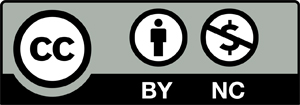Publication and Ethics
The JAARU publishes articles under the Creative Commons Attribution License (https://creativecommons.org/licenses/by-nc/4.0/) and uses CC BY 4.0 license.
The published articles in JAARU, including their graphics and data are free of charge under the condition giving proper credit of the considered article(s). In addition, the articles are available to researchers worldwide; and thus, they can be accessed and exchanged to interesting researchers. The JAARU considers that the open access articles boost the exchange of research results amongst scientists. However, for articles which may contain materials (such as text, tables, and figures) from other publications, i.e. the JAARU does not hold the copyright or the privilege to re-license those materials, the copyright holder of those materials should be given the proper credit of such materials.
Ethics
The authors are required to conduct their research in accordance with the professional academic practices and rules. The following are author(s) responsibilities that should be considered before submitting their manuscript:
The JAARU publishes articles under the Creative Commons Attribution License (https://creativecommons.org/licenses/by-nc/4.0/) and uses CC BY 4.0 license. The published articles in JAARU, including their graphics and data are free of charge under the condition giving proper credit of the considered article(s). In addition, the articles are available to researchers worldwide; and thus, they can be accessed and exchanged to interesting researchers. The JAARU considers that the open access articles boost the exchange of research results amongst scientists. However, for articles which may contain materials (such as text, tables, and figures) from other publications, i.e. the JAARU does not hold the copyright or the privilege to re-license those materials, the copyright holder of those materials should be given the proper credit of such materials. Ethics The authors are required to conduct their research in accordance with the professional academic practices and rules. The following are author(s) responsibilities that should be considered before submitting their manuscript:
- Duplicate ofsubmissionare not allowed, which includes:
- Submitting the same manuscript to two or more journals at once.
- Submitting and/or republishing of the same findings.
- Submitting a previously published work (partly or fully), except if the submitted manuscript is a development of previous work (the authors are required to provide a clear statement in the submitted manuscript).
- Diving one research project into many little papers (“salami slicing”).
- Authorship
- A substantial contribution to the design of the manuscript including: research idea, methodology design, dataset collection and preparation, and experimental analysis.
- Writing the manuscript or revising it critically for important intellectual content and final approval of the version to be published.
- The authorship order should be discussed.
- When manuscript’s authorship (including authorship order) is changed during project, a signed letter from all authors should be provided to the journal.
- All the authors are responsible for the content of the manuscript.
- Plagiarism: Author(s) should ensure that their manuscript is original. The following cases are considered plagiarism:
- No referencing for published and published ideas that have been used in the manuscript. In addition, copying, paraphrasing parts or claiming results of others work without referencing.
- Submit a manuscript in different language.
- The previously mentioned plagiarism cases may occur at any stage of manuscript preparation (planning, research, writing, or publication). Plagiarism in all forms is considered unacceptable and unethical.
- JARRUutilizesturnitin service for originality checking and plagiarism prevention. The allowed percentage of similarity check is:
- First submission is 20%
- Invited and revise manuscript is 25%
- Manuscript that has similarity more than the predefined percentage are returned to the author(s) to reduce the similarity percentage.
- Fraud: there are different cases of fraud, all forms of fraud are unacceptable. These forms are:
- Fabrication: including invention, addition, and/or addition of data or cases.
- Falsification: deliberate distortion of data which include:
- Manipulating materials, equipment, or processes.
- Ignoring results outliers.
- Not admitting that some data are missing.
- Post hoc analyses that are not admitted.
- Conflict of interest
- Financial gain such as:
- Research grants from funding agencies (please give the research funder and the grant number)
Financial support for attending symposia
- Financial gain such as:
- Employment or consultation
- Position on advisory board or board of directorsorother type of management relationships, they should clearly disclose that the paper goes through the review process oftheJAARU.
The following are examples that are provided by the authors for the conflict of interest:
- This work/study was funded fully/partially by X (grant details).
- Author(s) A (and B) have received research grants from X.
- The authors declare that they have no conflict of interest.
The Editors reserve the right to reject manuscripts that do not comply with the aforementioned guidelines. The author(s) will be held responsible for false statements or failure to fulfill the aforementioned mentioned guidelines.

